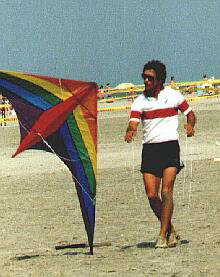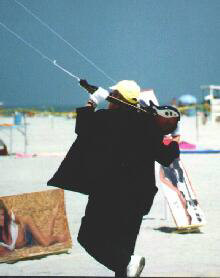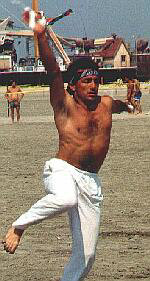Spring! When gentleman (and lady) kitefliers thoughts turn lightly to Kite Flying, much to the chagrin of their partners and spouses.
OK, LET’S TRY TO GET ORGANIZED!
In the flying seasons of 1985 and 1986 many kitefliers across the country were traveling a very different route then the rest of the average “Fun Fliers.” There were rules and regulations being created by the score. How long should a competitor get to fly on the competition field? What equipment can a flier use on the field? What should judges be looking for when they write a score down? What should the time limit be for Precision? The mid 80’s were the formative time in the history of organized competitive stunt kite flying.
There was a committee formed to examine the rules and regulations for this infant sport. Some of the most active kitefliers across the country were busily at work writing a formal rules booklet that would unify and clarify the competitions at the many stunt kite events taking place across the country.
Some of the most skilled kitefliers of all time were polishing their skills and practicing their performances for the coming season. A very few of the “best of the best” fliers were doing something very odd out on the fields. They were busy figuring out how to bend all those new rules!
HOW COME THERE AREN’T MORE RULES?
At many of the sport kite competitions I attended in the year 2000 the biggest topic of conversation seemed to be the need for more and better, much more comprehensive rules and regulations for the sport. Contestants were grumbling about the fact that the official rules booklets are never current and up to date. That they as competitors never get the precise, detailed and accurate criteria that dictate what they are required to do on that 300 by 300 official flying field. Pilots meetings at many of the events sounded like lectures on rules and procedures. Fliers were asking very detailed and intricate questions about what the judges are expecting to see. The fliers want to be very involved and feel they have the right to know. Problems were always coming up about pre-event information.
With the more extensive use of the Internet and event web sites, the fliers are able to see exactly what maneuvers they are expected to fly. There are even Internet sites that show many of the maneuvers in real time animation. You can get updates for regulations and procedures at the speed of electrons. The fliers of the year 2000 are better informed before a competition than the official rules committees were back in the 80’s. They are able to instantly access changes, additions and alterations to official procedures, criteria and rules. They can alter and tailor their competition routines to match the up to the minute electronic rule books! And it seems that with all this speed of light access to information, they are still not satisfied and want more and more rules!
LET’S TRY TO BEND THE RULES WITHOUT ACTUALLY BREAKING THEM.
In 1986 there were several fliers that just didn’t walk the same path as the rest of the competitors on the flying fields of the country. I’d like to relate a few stories about these “outlaws” from the 80’s One of these fliers was Ron Reich. Ron is well know as the brains behind the very successful stunt kite team Top of the Line Flight Team. Ron was also an excellent individual flier and was National Champion for several years.
One of Ron’s talents was the ability to fly two kites simultaneously. As the rules for Individual ballet at the time didn’t forbid this amazing feat, Ron flew two kites in regular ballet. This caused quite a stir among the rest of the Open Class competitors (open class was what masters class was called in 1986). What flier, no matter how good, could beat one of Ron’s double kite performances when they used only one kite? Ron never intended to break or even bend any of those existing rules. His only goal was to entertain the people who watched him fly. The rules were not specific about what equipment could be used or how many kites could be flown. Ron’s dual kite performances were a sight to behold. His choreography was excellent and his technique was smoother and more precise then any two other fliers.
As the 1986-87 season continued many competitors argued for more precisely worded rules for competition. They wanted to stop Ron and put themselves on a more equal footing with him at competitions. “It should be against the rules,” they would say. “It’s not fair and we need a regulation against it” were the frequent comments. Some competitors had a different outlook on what Ron Reich was attempting to express. They realized that art and entertainment was the object of Ron’s efforts and they began to come up with ideas of their own to present kiteflying in a new and “Innovative” way.
One of those imaginative fliers was Lee Sedgwick of Erie Pennsylvania. In 1986 Lee had only been involved in organized stunt kite flying for about two years. A virtual “beginner” by today’s standards. Lee’s flying from the start was excellent and he had a style of flying that was unique. He had body movements that sometimes matched his kites flight and closely resembled dancing. But alas, the judges and the current rules stated that “…nothing that the flier did on the ground would be judged… No flier movement, or acrobatics of any kind would be included in the final scores. …” Lee was not one to be stopped by a few words or simple rules when it came to entertaining a crowd. He had heard the judges say, often enough, that they would only be looking at the kite in a ballet competition routine and not at the flier.
 Lee’s solution was elegantly simple, yet perfectly effective. His plan was to move down to stand next to the kite during his routine. The judges would simply have to see him and his dancing when they looked at the kite. I had been good friends with Lee for about two years at that time and I was aware of his plans for his new routine. I was also lucky enough to be the field director at the East Coast Stunt Kite Championships in 1987 when Lee premiered his exciting new method of flying.
Lee’s solution was elegantly simple, yet perfectly effective. His plan was to move down to stand next to the kite during his routine. The judges would simply have to see him and his dancing when they looked at the kite. I had been good friends with Lee for about two years at that time and I was aware of his plans for his new routine. I was also lucky enough to be the field director at the East Coast Stunt Kite Championships in 1987 when Lee premiered his exciting new method of flying.
I knew what was going to happen when he gave me that grin of his and screwed that dog stake into the sand. We all know what Lee did out on that field in ’87 is now called “dog stake” or “solo” flying. And his “Lady in Red” routine is a classic. Lee knew that the rules would eventually be changed to outlaw Ron Reich’s dual kite routine.
Lee’s idea was to use only one kite and to simply alter the direction and angle of the flying line and his position on the field with the dog stake, so the judges would have a new and “Innovative” perspective to his routine.
Breaking the rules? I don’t think so! All you had to see was Lee and the kite dancing “….Cheek to Cheek…” at the exact instant those words were sung, to know Lee’s main goal was entertainment and the creation of kiteflying art. Ron and Lee alternated between first and second place in individual ballet, any place where they flew with each other that season. When it came right down to it Ron and Lee never felt that they were flying against each other as competitors. They were flying to entertain people and to create a new and exciting way for people to view stunt kite flying.
BUT WE MUST HAVE MORE RULES!
It was certainly true that Ron and Lee were not following the current rules, but they weren’t really trying to break those rules either. The rest of the stunt kite contestants in the country didn’t quite see Lee and Ron’s viewpoint. They saw these entertaining innovations as outlaw routines that were breaking the rules. There was a huge outcry for more detailed rules that would disallow two kite routines or extra hardware like a dog stake in individual ballet. The rules hammer finally fell at the 1987 National Convention in Washington, DC when the stunt kite rules committee ordered that Lee could not use a dog stake and Ron could only fly one kite. The rest of the grumbling contestants got their new rules and, as I recall, Ron and Lee split first and second place anyway. But the damage had been done, the rules had become an axe. A knife that began to cut at the heart and soul of exciting and entertaining kiteflying.
WHO CAN BE MORE IMAGINATIVE?
The sport kite committee in 1987 did realize that the routines of Ron, Lee and others were very entertaining for both regular kitefliers and the non-kiter audiences. They had changed the rules to outlaw these new routines in regular ballet, but they created a new category of competition for this type of flying and called it Innovative.
The 1988 stunt kite season was host to a spectacular array of new and exciting kite performances. Both Lee and Ron stayed at the top of those innovative flight orders, but they also spawned many copycat fliers that used dog screws or flew two kites simultaneously. The idea behind the Innovative competitions was to entertain the spectators and to allow fliers to “Think and Fly Differently”.
 You cannot imagine all the wonderful, weird and sometimes wacky routines that hit the fields that season. Fliers began to use several different kinds of kites and would alternate between types during their performances. Field set ups began to look like moving day with huge field crews and tons of hardware and props. Legendary and highly entertaining routines abounded.
You cannot imagine all the wonderful, weird and sometimes wacky routines that hit the fields that season. Fliers began to use several different kinds of kites and would alternate between types during their performances. Field set ups began to look like moving day with huge field crews and tons of hardware and props. Legendary and highly entertaining routines abounded.
Mal Moore from Hawaii had a routine that included wearing a space suit. Gary Counts of Pennsylvania dazzled crowds with his beautifully choreographed gymnastic dance routines. Eric Wolff was amazing when he flew his “Pictures at an Exhibition” Flexifoil routine. And no one can forget Pete Dolphin’s Tuxedo and ZZ Top dance routine. Not all the performances were picture perfect. Some were dismal failures from the contestants viewpoint. “Photo” Joe Perron almost lost his pants when he tried to fly two kites for the first time. He scored badly but the crowds loved it. Or the time when Bob Loera from Hawaii put a fiberglass ring around his quad line kite and flew to the music from the TV show Rawhide ( …Rollin’, Rollin’, Rollin,… get it?) But things didn’t go quite as planned for “Lava” Bob when the rods began to fly off into the crowd. Great fun, but Bob was pretty disappointed.
Or how about Phil Castillo who flew a dual line kite while blindfolded, or should I say crashed a kite while blindfolded. I even remember one guy who flew a tiny dual line kite with a rod between his teeth.
 Innovative? Well, yeah! Sort of! Entertaining? Most definitely! The Innovative competitions became the event to watch. There were flight orders at some events of more then 20 Innovative contestants. People would wait anxiously to see just what spectacular or weird thing each flier would come up with next. Crowds of spectators were the biggest for this entertaining and innovative new category of kite flying. No one knew what to do with all these performances and the comment often heard from judges for these events was “How do we judge Apples and Oranges?
Innovative? Well, yeah! Sort of! Entertaining? Most definitely! The Innovative competitions became the event to watch. There were flight orders at some events of more then 20 Innovative contestants. People would wait anxiously to see just what spectacular or weird thing each flier would come up with next. Crowds of spectators were the biggest for this entertaining and innovative new category of kite flying. No one knew what to do with all these performances and the comment often heard from judges for these events was “How do we judge Apples and Oranges?
SO HOW DO WE REALLY JUDGE THESE APPLES AND ORANGES?
Then something happened, something that changed the entire Innovative discipline. More detailed rules were written for the event. Just like lightning striking a tree and burning it to the ground, rules started to burn down the imagination of the kitefliers involved. In order to write a score and award a trophy to a winner the judges had to figure out a way to fairly score the widely varying performances of all these imaginative fliers. But with the elaboration of more and more rules the event called Innovative saw fewer and fewer contestants. Maybe fliers just started to run out of ideas, but I personally think that excessive rules, more then lack of innovative ideas were the death knell of this entertaining event.
The stunt kite rules committee sat down to their pens and pencils and wrote a detailed set of comprehensive rules, judging criteria and procedures for a contest that was seeing fewer and fewer participants. I will agree that trying to judge this event was very difficult. It was very difficult to write down a score for something as innovative and entertaining as the simple use of a three wheeled buggy in a kite routine, but it was Innovative! (One of the first buggies made by Peter Lynn seen in the USA was used by Lee Sedgwick in Innovative in Wildwood, NJ) Innovative was eventually renamed Freestyle because there was very little innovation being seen on the field.
The event degenerated into a flying contest between one or two fliers who were flying two kites simultaneously or using a dog stake, but never anything new or exciting. The rules committee added the final scoops of dirt to the grave when they decided to distribute score cards to spectators in the bleachers and had them also write scores. The general viewing public really only wanted to watch kiteflying, be entertained and applaud. They didn’t want to understand rules or write a score. I know that most sport kite events across the country no longer even schedule Freestyle as an event. Recent AKA Grand Nationals will usually have only three or four contestants for Freestyle from the entire United States.
HOW ABOUT A BIGGER AND MORE COMPREHENSIVE RULES BOOK?
As I stated in my last article my new direction for Tangents and Trivia is to look to the past and attempt to use history to gain insights into the present and future. I’m not really suggesting that we throw away the current rule book, or to alter the way Freestyle is being judged. I am suggesting that Freestyle and other areas of kiteflying like Individual Ballet were much more exciting both for the kitefliers and spectators, much better attended with many more participants when there were less restricting rules and procedures.
Think for a minute about the exciting event that was held at last years AKA Nationals called the Hot Tricks Shoot Out. This was probably one of the most attractive and best attended “happenings” at the convention. Why?
Could it be because there were no real rules to speak of? That one of the main “Criteria” for this event was innovation and imagination? I think that the current “powers that be” are moving in the right direction for a change with the example of the Trick Shoot Out and an attempt to keep detailed rules to a minimum.
Just take a look at buggying. Pretty popular, right? Anyone see a rules booklet about that area of kiteflying? I am suggesting that things might change if competitors at pilots meeting stopped asking for more detailed rules, clarified procedures and specific regulations and started thinking how they can slip under the barbed wire strung about in all the rules. I am by no means implying that competitors should start breaking the rules, I am trying to suggest that fliers begin to use their imaginations. Not trying to break existing rules, but trying new ideas and techniques for their performances that aren’t even thought of yet, and definitely not covered in any rules booklet. Maybe bending the rules just a little bit in the process wouldn’t be too bad! Innovation can be exciting and entertaining for everyone. With event attendance falling across the country, excitement is something that I think we can all agree that our hobby and sport of kiteflying could use right now.
I would like to close this installment of T & T with a subtle hint:
Watch out for some old guy who shows up for an Individual dual line ballet competition this season with a radio controlled quad line kite that’s flown with only two lines. Is there anything in the rules book that say he can’t do that?

